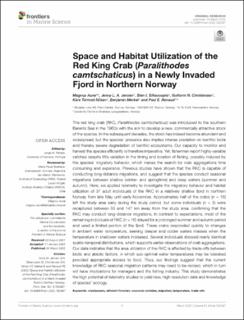| dc.description.abstract | The red king crab (RKC, Paralithodes camtschaticus) was introduced to the southern Barents Sea in the 1960s with the aim to develop a new, commercially attractive stock of the species. In the subsequent decades, the stock has indeed become abundant and widespread, but the species’ presence also implies intense predation on benthic biota and thereby severe degradation of benthic ecosystems. Our capacity to monitor and harvest the species efficiently is therefore imperative. Yet, fishermen report highly variable catches despite little variation in the timing and location of fishing, possibly induced by the species’ migratory behavior, which makes the search for crab aggregations time consuming and expensive. Previous studies have shown that the RKC is capable of conducting long-distance migrations, and suggest that the species conduct seasonal migrations between shallow (winter- and springtime) and deep waters (summer and autumn). Here, we applied telemetry to investigate the migratory behavior and habitat utilization of 37 adult individuals of the RKC in a relatively shallow fjord in northern Norway from late May until early November. Approximately half of the crabs (n = 16) left the study area early during the study period, but some individuals (n = 3) were recaptured between 53 and 147 km away from the study area, confirming that the RKC may conduct long-distance migrations. In contrast to expectations, most of the remaining individuals of RKC (n = 16) stayed for a prolonged summer and autumn period and used a limited portion of the fjord. These crabs responded quickly to changes in ambient water temperature, seeking deeper and colder waters masses when the temperature in shallower waters increased. Several individuals showed nearly identical spatio-temporal distributions, which supports earlier observations of crab aggregations. Our data indicates that the area utilization of the RKC is affected by trade-offs between biotic and abiotic factors, in which sub-optimal water temperatures may be tolerated provided appropriate access to food. Thus, our findings suggest that the current knowledge of RKC seasonal migration patterns may need to be revised, which in turn will have implications for managers and the fishing industry. This study demonstrates the high potential of telemetry studies to yield new, high-resolution data and knowledge of species’ ecology. | |
